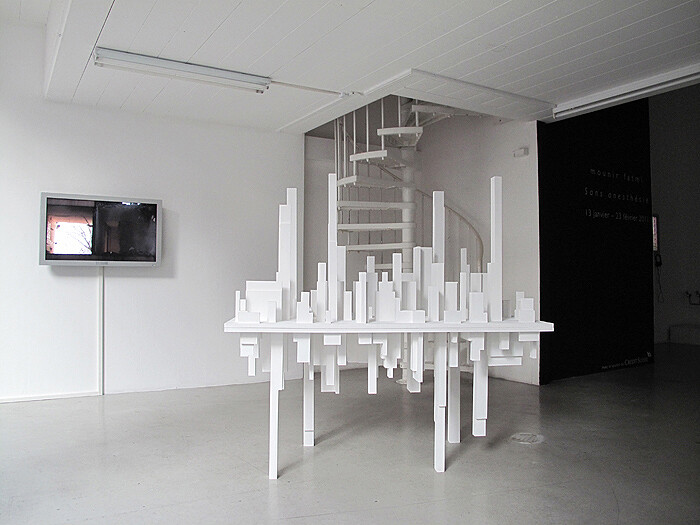mounir fatmi is an artist of resistance. It starts with his name, written lower case to challenge conventional orthographies that do not accommodate him. He was born in Tangier and lives in Paris, and the idea of exile and iconoclasm of Western, African, and Arab traditions appear frequently in his repertoire. His sculptural works tend toward the monumental in their concise, authoritative tone and their use of symbolic shorthand, so the chaotic din that greets the visitor behind the quiet shop-front of Analix Forever is surprising.
“Without Anaesthesia” is dominated by four video works generated during fatmi’s lengthy residency at Le Chaplin cultural centre in Mantes-la-Jolie. The “jolie” in the name is misleading, as today the town is best known not for beauty but rather the huge Val Fourré housing development in the Parisian banlieue where television crews go to capture suburban unrest and burning cars. The Val Fourré was built in the 1960s to meet a sharp increase in demand for homes, but the developers’ optimistic visions had clouded over even before the project was complete. Stifled funding brought about denser housing than originally planned and the project was not integrated into a broader transport infrastructure, leaving it marooned. Add to that poor sporting and educational facilities, and middle class earners jumped ship, making way for recent immigrant populations whose lack of linguistic integration isolated them further still. By the mid 1990s, the development had become a test case for failed civic architecture; demolition was part of every proposed solution.
fatmi has collated film documentation of different elements of the gradual demolition of Le Val Fourré during different periods of residency at Le Chaplin since 2002. The clanking of numerous heavily articulated bulldozers as they grab and drop detritus is ceaseless, while different musical accompaniments, from Schoenberg to hip-hop, weave through each video offering possible soundtracks, yet never fusing with conviction. Close framing shows mechanical hands that pick and pull at walls and floors, cutting out the drivers and foremen, who are as absent from the scene as the erstwhile residents. In the midst of these videos on three of the gallery walls is the all white sculpture Underneath, 2007, a pristinely painted wooden table pierced by high-rise oblongs. On one screen a series of colorful interiors caught in sunshine make a macabre riposte to the very notion that cosmetic improvement could salve the situation.
fatmi’s images are excruciatingly dumb and disquieting: surveillance footage that refuses to supply an explanation for itself. Rather than giving voice to the residents of Val Fourré, it’s fatmi’s camera that does all the talking here. The context of the artist’s residency is saturated with tension, and you don’t have to watch for long to get a sense of guilt. What can and should an artist do there? In an interview, fatmi recently admitted that, “producing an artistic proposition in response to what’s happening in the world is so complicated and perhaps pretentious.” In light of the specific context, fatmi has balanced the aestheticization of economic migration’s repercussions (when he brings these scenes into an art gallery) with the refusal to stamp his aesthetic on it, by presenting it simply and inconclusively.



